Victorian Era Worksheets
Do you want to save dozens of hours in time? Get your evenings and weekends back? Be able to teach about the Victorian Era to your students?
Our worksheet bundle includes a fact file and printable worksheets and student activities. Perfect for both the classroom and homeschooling!
Resource Examples
Click any of the example images below to view a larger version.
Fact File
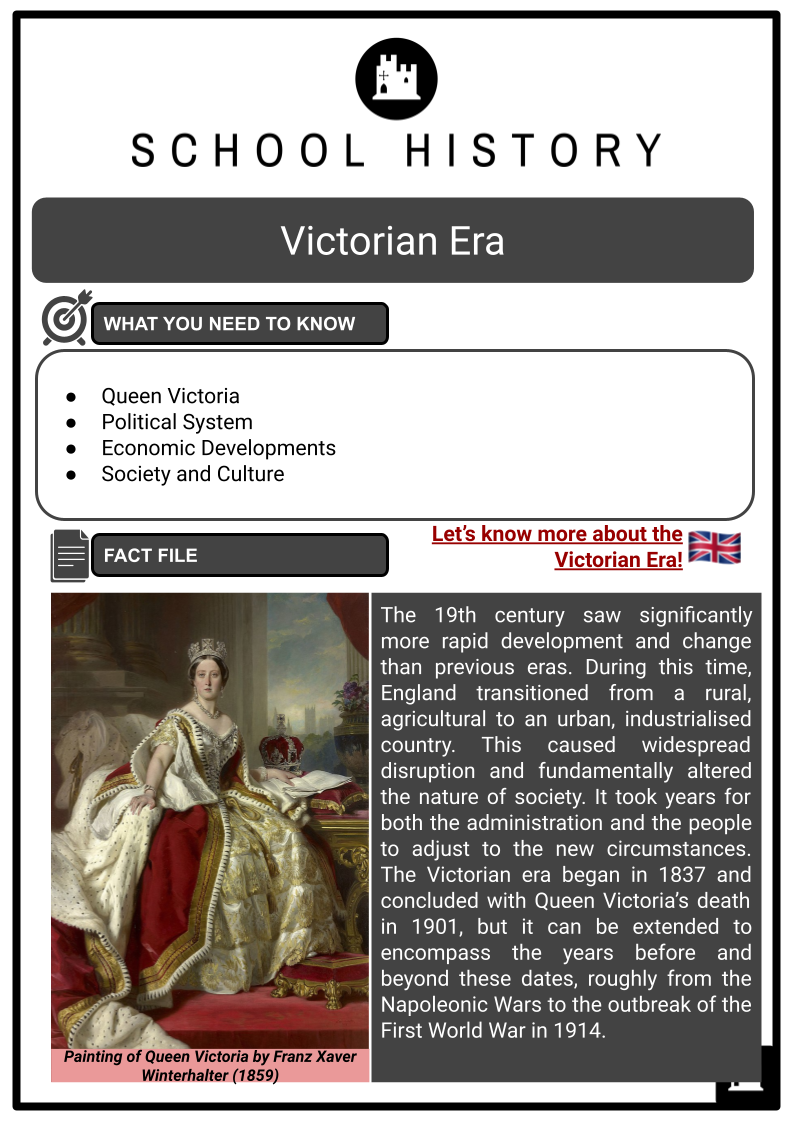
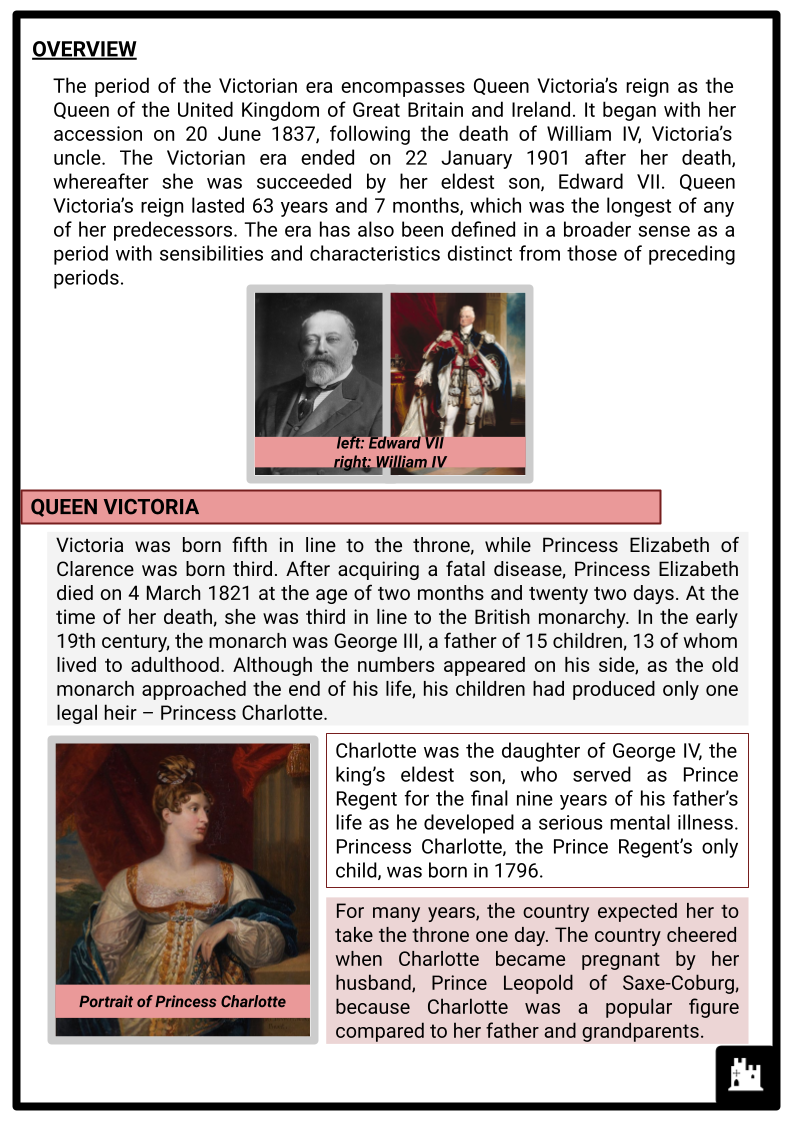
Student Activities
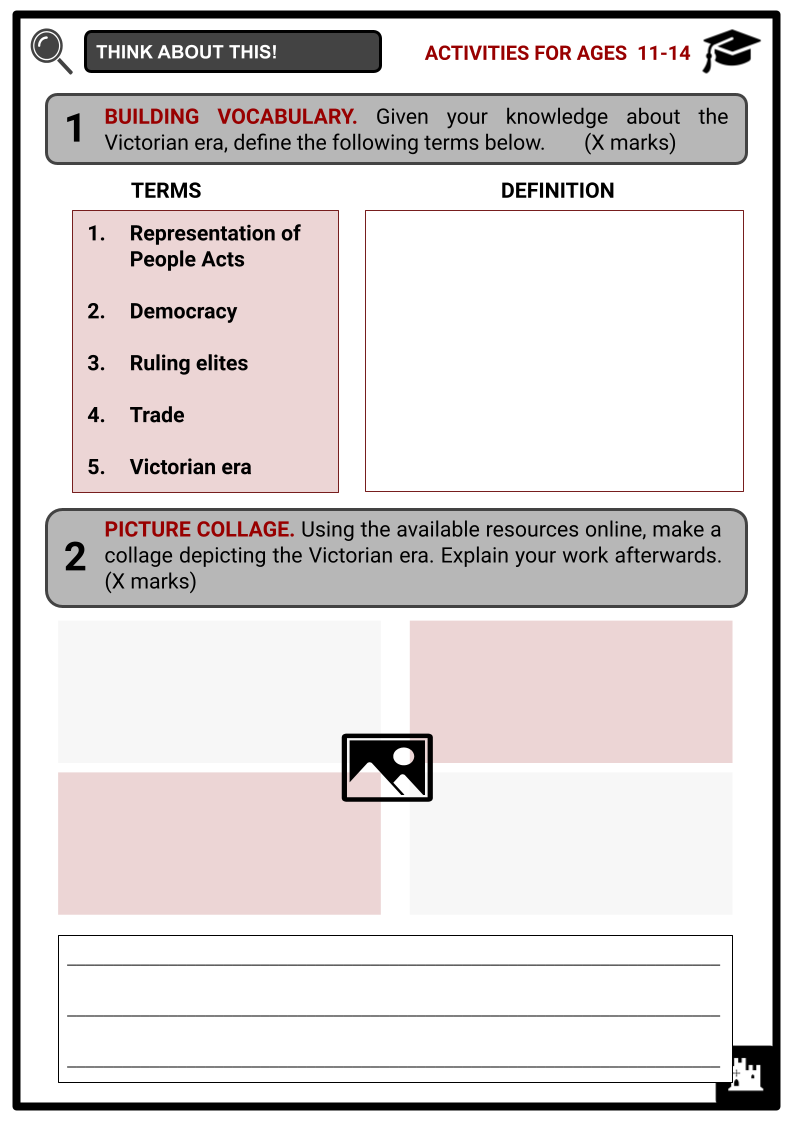
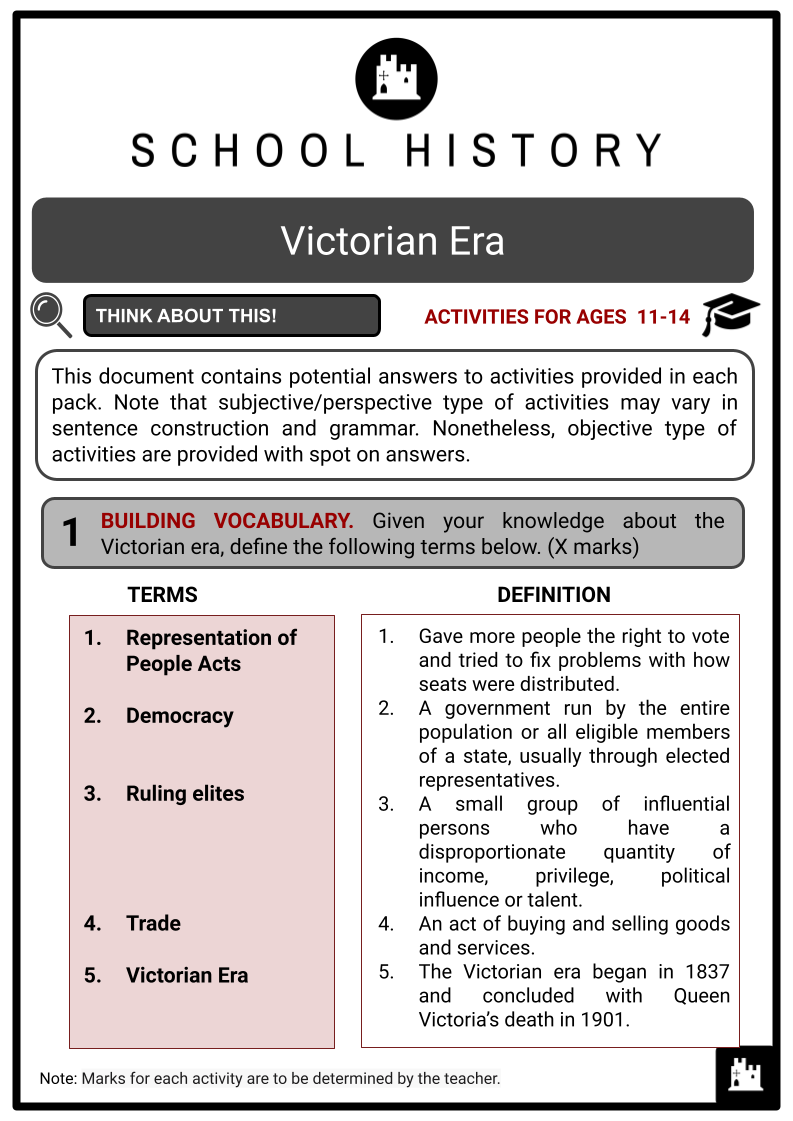
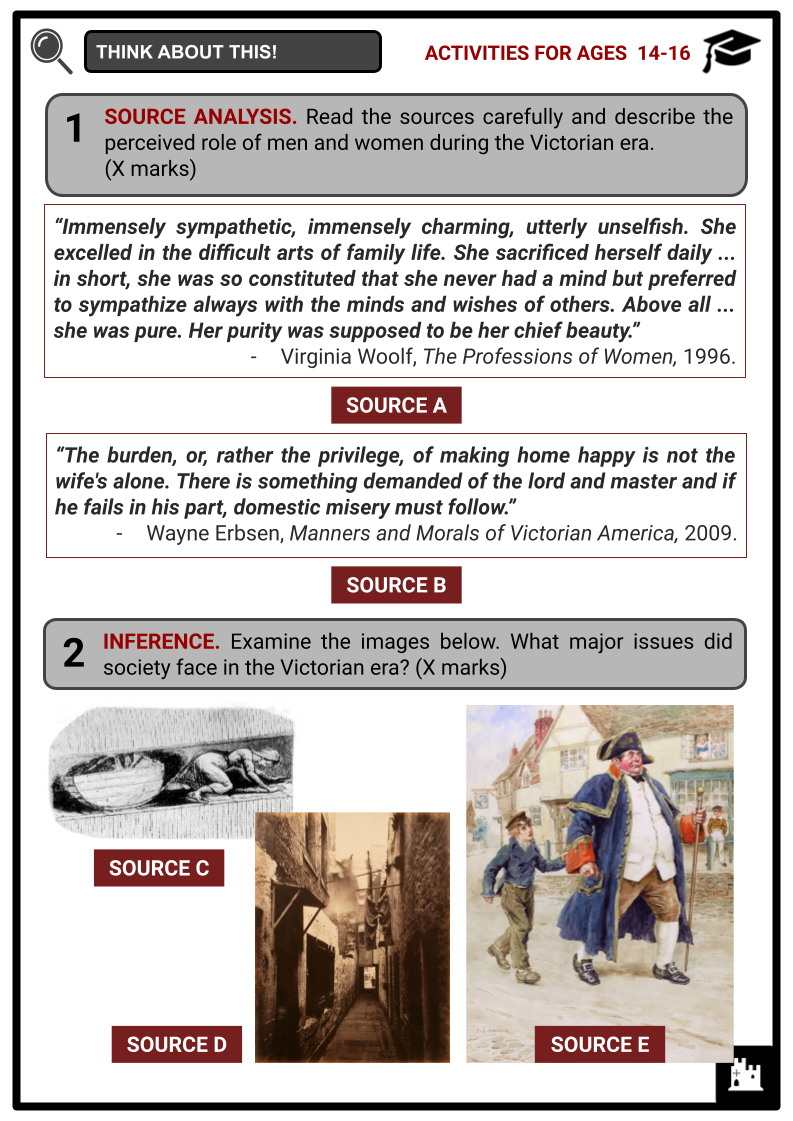
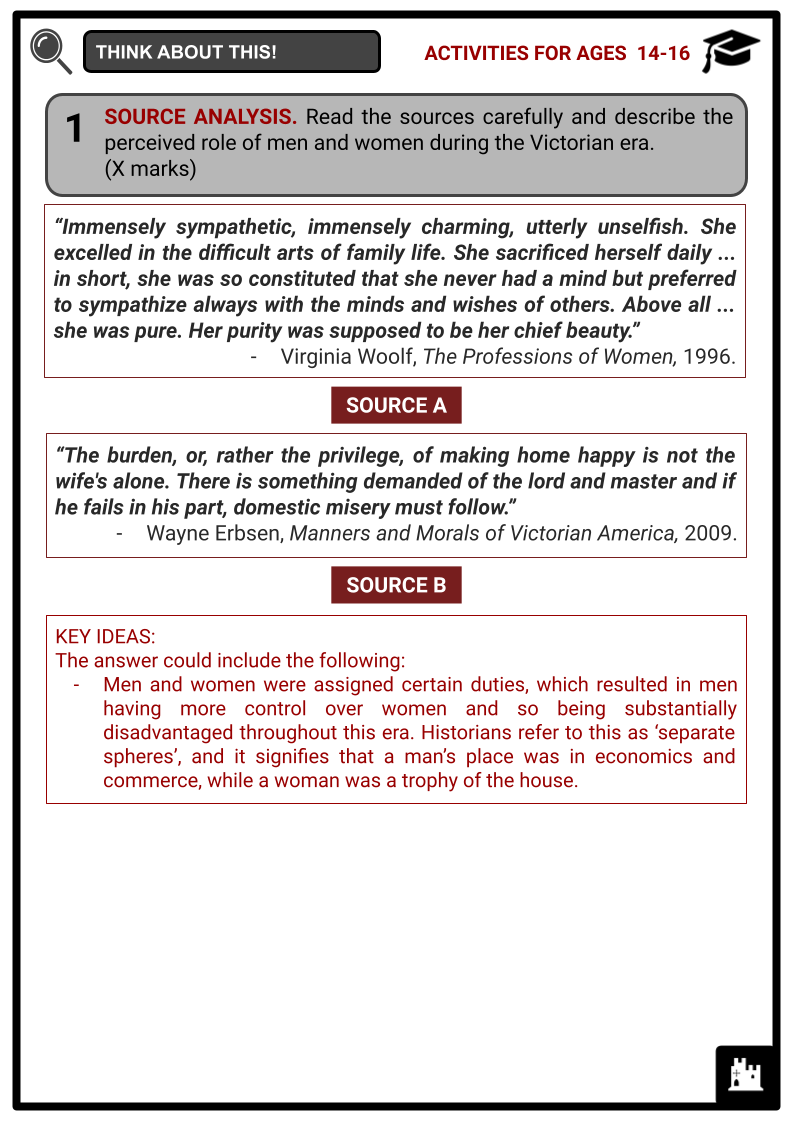
Summary
- Queen Victoria
- Political System
- Economic Developments
- Society and Culture
Key Facts And Information
Let’s find out more about the Victorian Era!
The 19th century saw significantly more rapid development and change than previous eras. During this time, England transitioned from a rural, agricultural to an urban, industrialised country. This caused widespread disruption and fundamentally altered the nature of society. It took years for both the administration and the people to adjust to the new circumstances. The Victorian era began in 1837 and concluded with Queen Victoria’s death in 1901, but it can be extended to encompass the years before and beyond these dates, roughly from the Napoleonic Wars to the outbreak of the First World War in 1914.
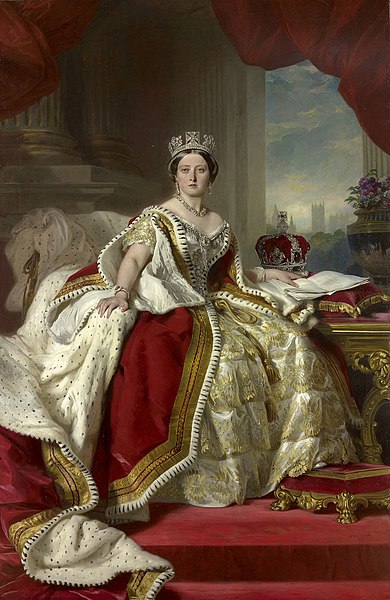
OVERVIEW
- The period of the Victorian era encompasses Queen Victoria’s reign as the Queen of the United Kingdom of Great Britain and Ireland. It began with her accession on 20 June 1837, following the death of William IV, Victoria’s uncle. The Victorian era ended on 22 January 1901 after her death, whereafter she was succeeded by her eldest son, Edward VII. Queen Victoria’s reign lasted 63 years and 7 months, which was the longest of any of her predecessors. The era has also been defined in a broader sense as a period with sensibilities and characteristics distinct from those of preceding periods.
QUEEN VICTORIA
- Victoria was born fifth in line to the throne, while Princess Elizabeth of Clarence was born third. After acquiring a fatal disease, Princess Elizabeth died on 4 March 1821 at the age of two months and twenty-two days. At the time of her death, she was third in line to the British monarchy. In the early 19th century, the monarch was George III, a father of 15 children, 13 of whom lived to adulthood. Although the numbers appeared on his side, as the old monarch approached the end of his life, his children had produced only one legal heir – Princess Charlotte.
- Charlotte was the daughter of George IV, the king’s eldest son, who served as Prince Regent for the final nine years of his father’s life as he developed a serious mental illness. Princess Charlotte, the Prince Regent’s only child, was born in 1796.
- For many years, the country expected her to take the throne one day. The country cheered when Charlotte became pregnant by her husband, Prince Leopold of Saxe-Coburg, because Charlotte was a popular figure compared to her father and grandparents.
- Elation quickly turned to sadness in 1817 when the princess gave birth to a stillborn boy. Charlotte succumbed to a fever and died just a few hours later. The nation mourned their deaths as two generations destined for the throne had been wiped out.
- As a result of the British monarchy’s succession dilemma, a ‘baby race’ among King George’s sons to produce a lawful heir began.
- The Prince Regent and Prince Frederick (King George’s second son) were swiftly ruled out of the race due to their advanced years and their wives’ separation. King George’s three oldest daughters, Charlotte, Augusta and Elizabeth, were all past childbearing age, and his sixth son, Augustus, had married in violation of the Royal Marriages Act of 1772.
- The Royal Marriages Act of 1772 was an Act to regulate the royal family’s future marriages better. The Parliament passed an Act imposing limits on the legalities of how members of the British royal family might marry. The Act stipulated that, without the permission of the incumbent monarch, no descendant of George II may marry.
- This left the King’s remaining sons, William Duke of Clarence and St Andrews; Edward, Duke of Kent; Ernest Augustus, Duke of Cumberland; and Adolphus, Duke of Cambridge, as the most likely contenders to sire an heir. If the throne wasn’t enough of a motivator, Parliament offered to pay off some of the Dukes’ massive debts if they were successful.
- In 1818, four marriages occurred as King George’s children battled to claim the throne for their bloodlines. One such wedding involved two German princesses: William married Princess Adelaide of Saxe-Meiningen, while Edward married Princess Victoria of Saxe-Coburg-Saalfeld. During May, Adolphus married another German princess, Princess Augusta of Hesse-Kassel, while Ernest Augustus married in 1815, giving him a head start on his brothers.
- Alexandrina was the name given to Edward and Victoria’s daughter. Her middle name, Victoria, was given to her because she was described as ‘plump as a partridge’. Edward was overjoyed and claimed loudly that her arrival meant ‘the crown will come to me and my children’.
- Edward lived long enough to see his daughter born but not long enough to become king. He died of pneumonia on 23 January 1820, just six days before his father.
- On 29 January, George IV rose to the throne and governed for the following ten years. His younger brother Frederick died during that period, leaving William, George III’s third son, as the next in line. And then there was Victoria.
- On 26 June 1830, George IV died, leaving the kingdom to his younger, childless brother William. William reigned for another seven years before dying on 20 June 1837. Victoria ascended to the throne at the age of 18 on that day.
POLITICAL SYSTEM
- During the 19th century, the Victorian Parliament had a significant impact on the evolution of democracy in the country. This period was marked by a gradual process of transformation, highlighted by significant reforms that had a significant impact on the functioning of Parliament.
- The Representation of People Acts, also known as the Reform Acts, of 1832, 1867 and 1884 had a big effect on the electorate because they gave more people the right to vote and tried to fix problems with how seats were distributed.
- As a result of these alterations, the composition of the Parliament exhibited a greater degree of representation with respect to the entire population. Moreover, during this era, there was a notable emergence of parliamentary debates, which served to augment public engagement and foster a more vibrant political procedure.
- This led to an increased sense of legitimacy and responsiveness towards public sentiment. The parliamentary institution exerts impact on the democratic process through its role in scrutinising and ensuring accountability for the actions of the executive branch.
- Members of Parliament engage in various activities like debates and committee work to critically examine the actions of the government, promoting openness and accountability.
- Nevertheless, it is important to acknowledge that the aforementioned domain of influence was predominantly reserved for the privileged few, as the working class and women were predominantly excluded from participating in it.
- This situation gradually began to change, with movements pushing for further democratisation towards the end of the century, laying the groundwork for the more progressive, inclusive democracy of Edwardian Britain and beyond.
POLITICAL PARTIES
- The political parties during the Victorian era in Britain had a pivotal role in influencing the country’s system of government and facilitating its evolution towards a contemporary democratic framework.
- By providing a venue for cooperative decision-making, politicians with similar goals and concerns might work together to push changes and participate in power struggles. During the Victorian era, the two major political parties were the Liberal Party and the Conservative Party.
ECONOMIC DEVELOPMENTS
- In the early Victorian era, agriculture was the backbone of the British economy. Improvements in farming practices led to increased productivity, feeding a rapidly growing population and providing raw materials for emerging industries. Agricultural mechanisation, improved seed drilling techniques and implementation of crop rotation contributed to a more productive agricultural sector.
- In addition, the Enclosure Acts played a crucial role. They allowed for land consolidation, which led to more efficient farming. The agricultural sector also benefited from advancements in transport infrastructure, such as canals and railways, which facilitated the movement of agricultural goods, linking rural production sites to urban consumers.
- However, with the onset of the Industrial Revolution, Britain saw a significant transition from an agrarian economy to a more industrialised one. The promise of employment in factories drew many workers from rural areas to cities. While agriculture played a lesser role in the economy towards the end of the era, its importance as the starting point of Britain’s economic transformation should not be forgotten.
- Although it’s noteworthy that the transition from agriculture wasn’t entirely devoid of challenges, the advent of cheap imported grain following the repeal of the Corn Laws in 1846 severely impacted British farmers. This illustrates the mixed outcomes of economic developments and the inherent complexities of such transformations.
- The Victorian era is commonly characterised as the ‘Golden Age of Trade’. During this century, a plethora of key trade agreements were negotiated, backed by progressive policies that allowed the expansion and enlargement of global trade networks. During this age, the advancement of railway and maritime technologies played a crucial role in boosting trade, resulting in quicker and more effective movement of products.
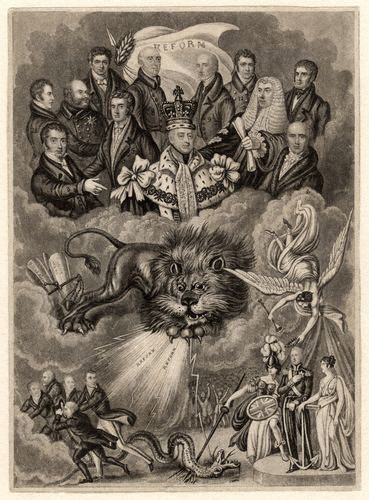
MID-VICTORIAN BOOM
- The years after the Great Reform Act of 1832 saw the continued social and political struggle between classes centred on the conflict of interest between the new middle class and the aristocracy.
- Meanwhile, the 1840s saw the culmination of the Age of Revolution that politically impacted most of Europe and the Americas. By the 1850s, Britain had gone into an era called the Age of Equipoise, based on the high degree of social and political calm alongside better standards of living for most of the population.
- As the first nation to make the industrial jump, Britain was able to progress ahead of other nations thanks to its highly advanced industrial sectors and the growth of its export industries.
- From around 1850 to the early 1870s, Britain was at the peak of its manufacturing and industrial dominance with the following main features:
- Export boom of manufactured goods
- Technological and scientific progress
- Cheap imports of raw materials
- Growing shipping with ports providing services for international trade
- Open markets, free trade, and generally peaceful international relations
- Apart from the years of peace enjoyed by Britain, better education and public health also made the mid-Victorian period an age of improvement. While poverty remained, the standard of living was generally raised.
- The economic structural change of the period was also characterised by a shift of resources from agriculture to services. Britain attained what seemed to be the perfect combination of social stability and economic growth in the mid-Victorian period.
VICTORIAN BRITISH EMPIRE
- Though its systems of control and influence were varied and diverse, the Victorian British Empire ruled the world. The movement of people and things between the United Kingdom and its colonies was continuous, complex and multidirectional. The empire shaped Britain, the empire shaped the colonies, and the colonies shaped one another. Civil and military service, missionary work and infrastructure building were all examples of British jobs abroad.
- People from numerous imperial territories came to Britain to travel, study and establish. Money moved both ways – the empire was profitable, and emigrants paid money back to Britain – as did goods like jute, calico cotton cloth and tea.
- Because of the empire’s dramatic expansion, such commodities came to Britain from all over the world. Between 1820 and 1870, the empire expanded, switched its focus eastwards and increased the number of non-white people under its authority. Much of this expansion was characterised by violence, particularly the Indian Mutiny.
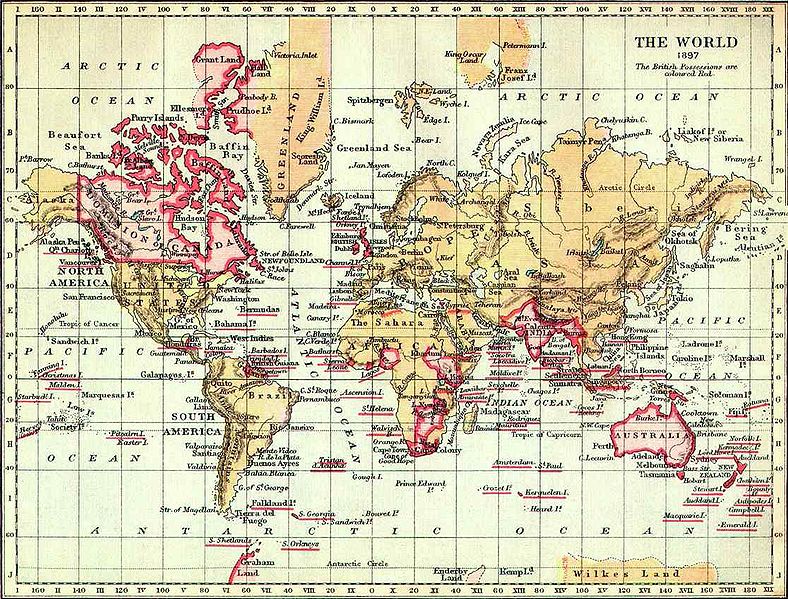
- India grew in importance in terms of imperial power and wealth. Significant migration occurred to the settlement colonies of Australia and New Zealand and later to Canada and South Africa. From 1870 to 1914, new technology, such as railways and telegraphy, aided ongoing aggressive development.
- Britain seized control of huge portions of Africa (including Egypt, Sudan and Kenya), which were home to roughly 30% of the African population. During the same period, anti-colonial groups in India and elsewhere began to demand independence from British rule. These would eventually lead to decolonisation following the Second World War.
SOCIETY AND CULTURE
- During the Victorian era, there were significant societal changes, particularly in terms of class and geographical separation. During this time period, the Industrial Revolution had a huge impact on society because it not only changed the economic structure but also caused changes in social stratification.
- The expansion of the middle class was a prominent phenomenon observed throughout the Victorian era, mostly attributable to the proliferation of employment prospects in domains such as industrial management and trade-related endeavours.
- Significant socio-economic changes occurred in the United Kingdom throughout the Victorian era, particularly in terms of class and geographical division. The Industrial Revolution had a major impact on society during this time period since it not only affected the economic structure but also produced changes in social stratification.
- Regional disparities were also notable, as the southern region of England, particularly London, experienced increased prosperity as a result of the clustering of businesses and industries in that area. In contrast, the northern region and Wales, which heavily relied on old industries such as coal and steel, encountered economic stagnation.
- From these class and regional divisions, it can be seen that there was a notable contrast between prosperity and poverty during the Victorian era. The process of industrialisation resulted in substantial accumulation of wealth, particularly in the southern region of England, giving rise to a discernibly affluent middle and upper socio-economic stratum.
- There was a significant prevalence of poverty in addition to the prevalent affluence. The poor were largely concentrated in rural and urban working-class communities, with a noticeable concentration in the North’s industrialised districts.
- People in the upper classes led extraordinarily affluent lives during the Victorian era, and they frequently flaunted their wealth by hosting lavish parties and beautifying their mansions. The impoverished people, on the other hand, had to deal with harsh living and working conditions.
RULING ELITES
- The ruling elites wielded considerable power throughout Victorian Britain’s political systems. They had tremendous political power and were mostly made up of landed nobility, royalty and wealthy business elites.
- Despite a growing electorate, the ruling elites maintained their influence and authority during the Victorian era. Political authority was primarily concentrated among the nobles and gentry, who had owned land for centuries. They constituted a disproportionately big block in Parliament, ensuring that their concerns were prioritised.
- Swift industrialisation brought a new class of wealthy industrialists and merchants, often referred to as ‘new money’. Many from this group managed to successfully enter the political arena, but their acceptance among the traditional elites was gradual and often fraught with tension.
- The ruling elites significantly shaped Victorian Britain’s political, socio-economic and cultural landscapes. Their actions and decisions amid a rapidly changing society played a crucial role in shaping modern British democracy.
WORKING CLASS
- The working class was made up of unskilled labourers who were subjected to harsh and unclean working conditions. They lacked access to clean water, food, education, and suitable clothing for their children. They frequently lived on the streets and were far from available employment, so they had to walk to get where they needed to go. Unfortunately, many workers turned to substances such as opium and alcohol to cope with their troubles.
UNDERCLASS
- The Underclass consisted of persons who were powerless and relied on the assistance of others. The destitute and orphaned children relied on donations to survive. Some untrained women who couldn’t find work became prostitutes to make ends meet. Because they were highly contentious, Parliament decided to pass the Contagious Diseases Act (1864, 1866 and 1869), which permitted prostitution in garrison towns but required women to be forcibly examined for infections. The measure was intended to protect men from disease transmission, not women from injury.
CHILD LABOUR
- There was an early baby boom during the Victorian era, which resulted in an increase in population and the growth of industrialisation. As England developed as a society, there was a larger demand for labour from adults and children.
- Children worked as coal miners, chimney sweepers, farm workers and domestic staff. Because the Industrial Revolution invented the railway, some youngsters were forced to work as railway workers.
- Child labour became a major issue in the early 1800s due to the upper class’s failure to improve working conditions. Because the affluent encouraged the government to spend on luxury rather than promote labourer protection, many children suffered at work. Coal mines were the most brutal places for children to work. Children were forced to work 12 to 18 hours a day in mines plagued with rodents and sickness, with little ventilation. Because of the difficult working conditions, there was an upsurge in mine disasters/casualties.
CHILD CARE
- As the population grew, the term illegitimacy became widespread in English society. Due to poverty and unstable marriages, many parents, particularly those from the lower classes, were unable to maintain and account for their children.
- It was also common for people to have children outside of marriage. A child was labelled a bastard if the male would abandon all support and care of the child to the mother.
- Bastardy became a problem for children, resulting in an unstable family environment and, more crucially, limiting fair access to education. As a result, the Bastardy Clause was adopted to provide relief for illegitimate children. However, it increased children’s illegitimacy.
- The Bastardy Clause, commonly known as the Poor Law Amendment Act of 1834, forbade parishes from assisting unwed mothers. The rule forced women and children without fathers to enter workhouses, which earned them a bad reputation. Some individuals, however, supported the bill since it would provide food and clothing to the needy and schooling for children.
- Because poor women could not afford to sustain their children, the majority decided to work as servants and live in the homes of their employers without their children.
- Mothers were motivated to continue working in the city since the salaries were higher, but chose to raise their children in villages and towns with strangers where conditions were safer.
- Unfortunately, this type of desertion resulted in worsening child treatment and protracted child labour.
WORKHOUSES
- During the Victorian era, there were significant disparities in living conditions between the rich and the poor. Many houses were built rapidly, of poor quality, wet and cold. There was no running water or appropriate sanitation in the houses, and multiple families often shared one house, with each family living in only one or two rooms.
- Diseases spread easily because people lived in such close quarters. The Queen Street plan demonstrates how little space they had.
- Reverend John Clay released The Report on the Sanitary Conditions of Preston in 1842. He said that Preston’s high death rate was caused by substandard housing, ineffective sewerage and water systems, and garbage buildup.
PUBLIC HEALTH
- Numerous elements influenced health and hygiene throughout the Victorian era. With the increase in population in England, particularly in London, a rising number of concerning diseases such as cholera, influenza, typhus, typhoid and tuberculosis arose in waves. There was a widespread health difference between the wealthy and the poor.
- Many charlatans made a fortune in the Victorian era by claiming the key to remedies for diseases ranging from typhus to tuberculosis.
- There was a boom in sewage innovation, a wide range of legislation and community participation aimed at substantially improving health and hygiene. The Baths and Washhouses statutes of 1846 and 1847, the Towns Improvements Clauses of 1847, and the Public Health Act of 1848 were among the major statutes enacted in the 19th century.
- Edwin Chadwick, an architect involved in the 1834 Poor Law, proposed the Public Health Act 1848. After another cholera outbreak in 1848, Parliament was forced to act, and the Act was approved. It established a Central Board of Health and formed corporations responsible for drainage, water supplies, nuisance removal, and paving.
- It also authorised the burial of the deceased, as there were so many deaths during this period that appropriate corpse disposal had not been a true priority unless otherwise indicated by those affluent enough to afford it.
- John Snow, a physician and pioneer in creating medicinal hygiene, attempted to disprove the miasma hypothesis by demonstrating the link between contaminated water and cholera.
- During this time, the construction of sewers and the invention of the flushing toilet also contributed to reducing disease cases. Inside the home, water closets were becoming more common.
- After the ‘Great Stink’ of 1858, there were efforts to clean the Thames, as well as individuals scouring the streets around Covent Garden in the hopes of ridding the neighbourhood of cholera.
- However, it was during the Victorian era that scientific discovery highlighted the aspects of everyday Victorian life that needed to be reformed or eliminated.
Frequently Asked Questions
- What was the Victorian Era?
The Victorian Era refers to the period of Queen Victoria's reign from 1837 to 1901. It was a time of significant social, economic, and cultural change.
- What were the significant characteristics of the Victorian Era?
Industrialisation, urbanisation, strict social hierarchies, moral values, technological advancements, and the expansion of the British Empire characterised the Victorian Era.
- What was the impact of the Industrial Revolution on Victorian society?
The Industrial Revolution transformed the economy, leading to urbanisation, the growth of the middle class, and increased production. However, it also resulted in poor working conditions and social inequality.
